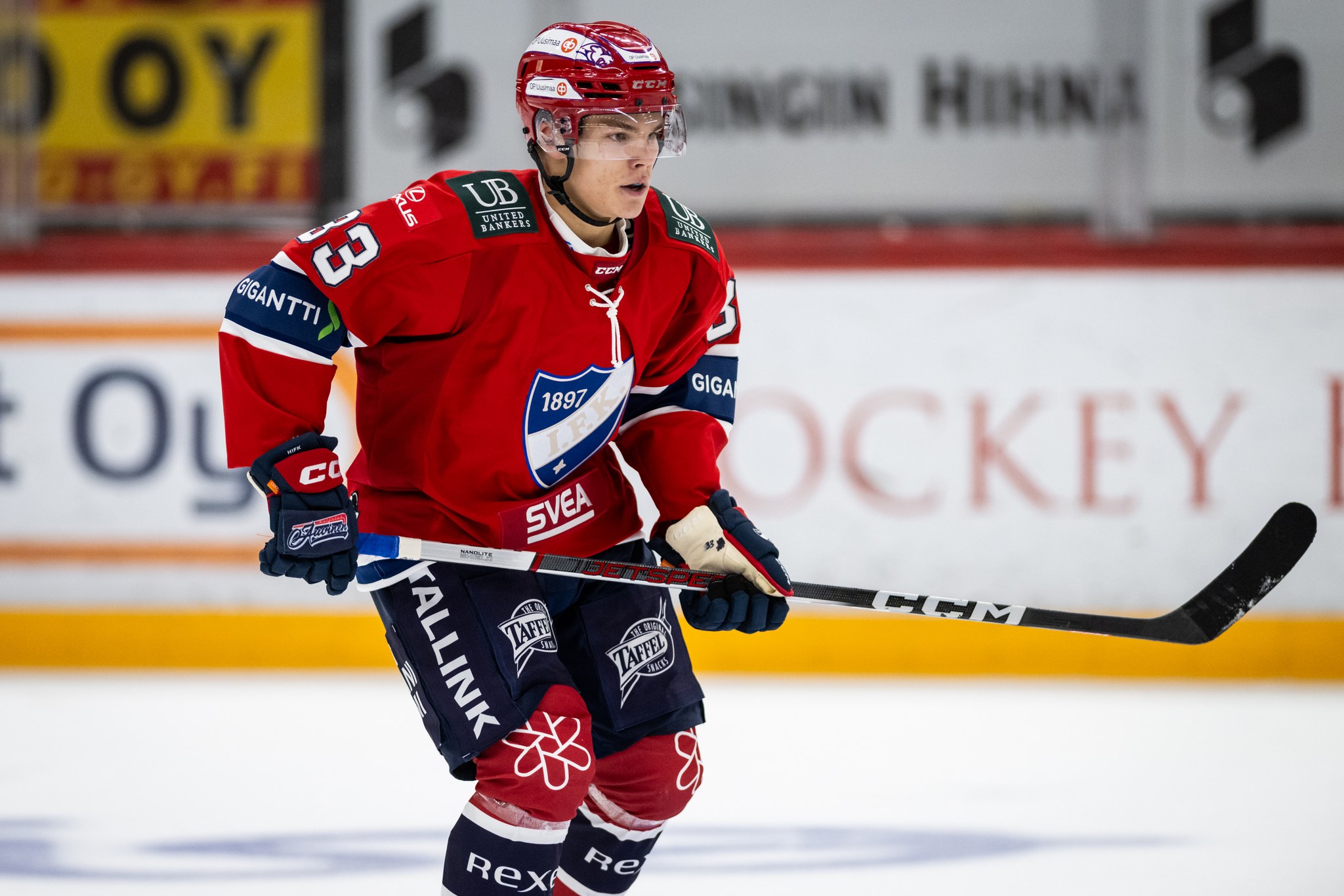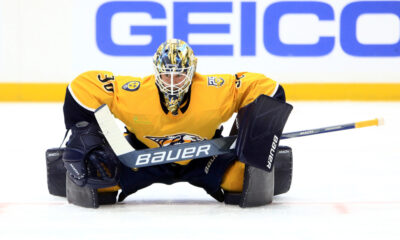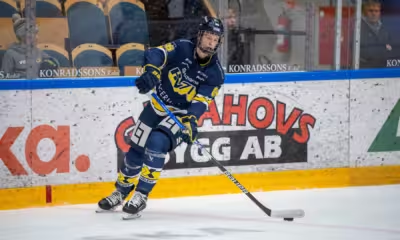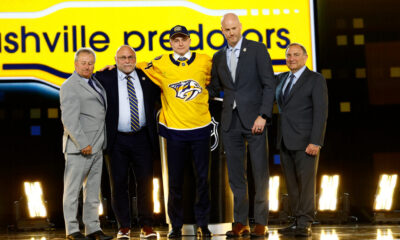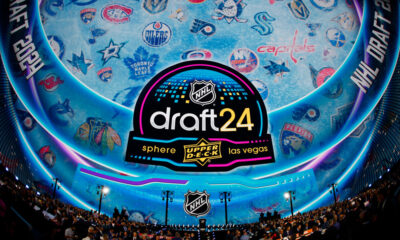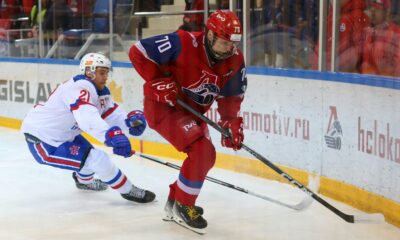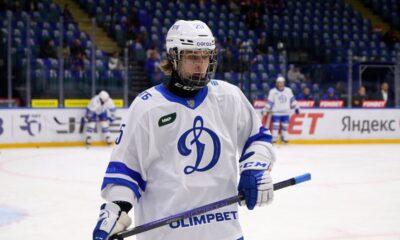On Saturday, the Nashville Predators will draft 55th and 59th overall at the 2024 NHL Draft, losing a previous second-round pick in a recent trade with Detroit. This week, I’m picturing what Nashville’s draft board could look like for each of their picks at the 2024 NHL Draft. As always, this will include prospects the Predators should target or may already be connected to.
Aron Kiviharju | D | HIFK (Liiga)
Once upon a time, years ago, Aron Kiviharju was a serious threat to be taken first overall at the 2024 NHL Draft. And now here we are talking about him in the second round. So what happened? The most obvious answer is that a knee injury forced him to miss most of this season; in seven Liiga games, he scored one goal and two points and returned in time for the U18 World Junior Championship (WJC), notching three assists in his third tournament. Injury aside, there’s a bit more at play here.
Kiviharju is a good skater, but at his size, you want him to be a great skater. Most of the ingredients are there: he has good edge control, his backward C-cuts are powerful, he uses linear crossovers to manipulate opponents in transition, and more. But he just isn’t quite as quick as you’d hope, and his acceleration out of his pivots is lacking. At the U18 WJC, we saw just how easily that can be exploited against top competition; hopefully, a summer of continued rehabilitation will help.
Defensively, Kiviharju maintains good position, preferring to use his stick instead of his body against rushing opponents. He makes quick decisions on puck retrievals and scans the ice well to avoid giveaways. His in-zone defense can be inconsistent, especially if he’s muscled off a puck by bigger opposition, but that will improve with time.
Going the other way, Kiviharju’s transition skills attract you to his game. When he emerges from his end with the puck, he’s got an excellent sense of the entire ice before him and an idea of what the consequences of any decision he makes will be. He’ll slingshot around his net or drive at forecheckers before making a quick move to get past them before executing a firm stretch pass or a cross-ice, no-look dish. In the offensive zone, he isn’t the flashiest player. But Kiviharju makes tons of smart plays, patrolling the blue line with elasticity, dropping down into open slots when possible, and distributing crisp passes from the point at even strength and on the power play.
Taking Kiviharju may be a risk, but with his pedigree, I’d swing all day long in round two.
Adam Jecho | W | Edmonton Oil Kings (WHL)
Adam Jecho has had an interesting career to date; he grew up in Czechia, went to play on the junior circuit in Finland, and last year, joined the Edmonton Oil Kings in the WHL. In 54 games as a rookie, he scored 23 goals and 47 points, finishing fourth on the team in scoring. On top of that, he added three points at his second U18 WJC.
What makes Jecho stand out isn’t that he’s 6’5″ and 200 pounds, it’s that he’s 6’5″, 200 pounds, and plays almost nothing like it. First off, Jecho is a genuinely good skater and not just relative to others his size. He’s got powerful stride extensions that help him power up the ice with good technique and proper posture. He pivots well in multiple directions when working near the point on the power play, and he does his best to limit wide turns in favor of quick stops and starts.
Thanks to those skills, Jecho is a powerful weapon in transition, managing the puck and pulling away from defenders with good stickhandling and his long reach. On the attack, Jecho probably won’t be a team’s F1 forechecker, but he’s a patient and sound F2 or F3 who provides good puck support up the wall or can drive to the net and win battles with his size. Jecho’s shot is a legitimate weapon too, especially on the man advantage.
As he continues to grow, Jecho will need to use his body to a better advantage. Despite his frame, he still gets poked off too many pucks, and his cycle play could improve with better puck-protection technique. I also have some concerns about his future playmaking abilities. His hands aren’t an issue, but he doesn’t always think ahead enough to connect on a brilliant pass or spin off a defender to delay the rush. Regardless, his size is attractive, and he’s got skills to boot.
Harrison Brunicke | D | Kamloops Blazers (WHL)
I don’t think Harrison Brunicke has gotten enough hype during this draft cycle; he’s likely a first-round talent but could very well be available in the 50s. The 6’3″ prospect is a right-shot defender born in South Africa. He starred for the Kamloops Blazers this year, scoring ten goals and 21 points in 49 games; at the U18 WJC, he added four points in seven games for Team Canada.
The first thing you notice about Brunicke’s game is that he’s everywhere. On each shift, he’s hard not to notice — for better or for worse. Starting in his end, Brunicke can completely shut down the high-danger areas on his best nights. He’s got enough size to bully opponents in front of his net, but he’s agile enough to jump behind the net or into the corner to force a turnover too. Against the rush, Brunicke uses every tool available to end the play: his feet, his stick, his body; whatever it is, he’s very good at forcing puck carriers to go wide or dump the puck in.
In transition, Brunicke can be mesmerizing. Forecheckers think they’re forcing him into a move, but in reality, he’s stepping into them before executing a creative deke or an impressive stretch pass. He’ll burst up the ice with his powerful skating skills and his head up ready to make a play. As he’s carrying the puck, he’s scanning the ice well, deciding between his options while keeping his pace. That creativity and confidence extend to the offensive zone, where Brunicke will fool wingers at the blue line, activate down the backside to deke out the goalie, or fire a heavy wrist shot to the back of the net.
The downside of Brunicke’s game is because he’s so active at both ends (almost trying too much at times), he’s prone to mistakes. Sometimes his rush chance catches him out of position when the play’s reversed; he has the speed to get back into things, but a skilled puck carrier can exploit his discombobulation. Sometimes he’ll miss a move in the offensive zone and take a wide, slow turn to recover. And sometimes he’ll just completely fall apart on puck retrievals. The key to a successful NHL future for Brunicke is learning when to pick his battles and with that, discipline will come.
Jack Berglund | F | Färjestad BK J20 (J20 Nationell)
Jack Berglund has had a lot of doubters this season, and there are legitimate criticisms of his game. But Bob McKenzie’s draft rankings indicate that NHL scouts are higher on him, and I believe there’s plenty of reason why. The 6’3″ Swedish forward is a physical presence on the ice, standing at just over 200 pounds. In 41 games this year in the J20 Nationell, he scored 15 goals and 34 points. He also got an eight-game stint in the SHL, scoring his first professional goal, and notched five points in seven games at the U18 WJC.
Adept at playing center or wing, Jack Berglund appreciates the small details of the game. He works hard in the faceoff dot, making little adjustments to win battles against varying opponents. He’s a steady hand with the puck, facilitating his teammates who may have better shots or better moves. And he’s successful in transition, understanding how he can open up the game by drawing opponents away from his teammates.
In the offensive zone, Berglund has a fine shot and okay puckhandling skills, but he’s more of a distributor. He’ll hit a teammate perfectly in stride as they crash into the slot, setting up an immediate scoring chance; or he’ll pull up once he crosses the blueline, dragging a defender to the wall before making a smart play down the boards or across the ice. He shoots for rebounds, can play the net-front, and more.
Defensively, Berglund’s attention to detail becomes more apparent. He’s persistent in his man-to-man defense, making smart efforts to disrupt the other team’s possession. To make it to the NHL, he’ll need to keep that up as his skating tends to break down and hinder him. If Berglund can prevent from falling behind the play, he’s got the hockey sense to be a perfectly fine complementary forward.
Leon Muggli | D | EV Zug (NL)
Leon Muggli has caught my eye a lot this season, and he’s poised to be another notch in the belt of the Swiss National League (NL) when it comes to draft pedigree. The 6’0″ defender has grown up in the Zug program. Aside from a handful of U20 games at the beginning of the season, Muggli spent the whole year with EV Zug in the NHL, scoring three goals and 12 points in 42 games. At the U18 WJC, he captained Switzerland and totaled two points in seven games between that contest and the U20 WJC.
When you’re watching Muggli’s tape, you’d be hard-pressed to find anything he does seriously wrong. His skating mechanics are good, and you can tell how well he’s able to flow up and down the ice. His explosiveness is decent as is his lateral agility too. Defensively, Muggli gaps up well, powers his way backward, and slowly works his opponents to the outside before dislodging the puck. In front of his net, he finds good positioning and responds quickly to shifting plays even if he’s not all that physical.
In transition, Muggli is quick to emerge from behind his net, powering across the blue line. He exits his zone with confidence, connecting on a crisp pass or making an effective move himself. His zone entries could improve as he sometimes defaults to just dropping the puck on the net, but in the offensive zone, he’s much more of a distributor from the point. He sees the ice well, keeping his head up during rushes, and understands how to exploit layers of defense with plain-looking moves.
The knock on Muggli is, of course, that he does nothing exceptionally well. When it comes to physical traits, that may be right but that can also change. Additionally, I think Muggli is brilliantly smart in how he thinks about the game. In many viewings, I saw him make the slightest adjustments — like how his stick is positioned when facing down a forechecker or at what angle he takes a puck retrieval to slip possession to his D partner — that made a world of difference. In my mind, there’s an extremely solid chance he can be a second-pair defender in the NHL for a long time.

